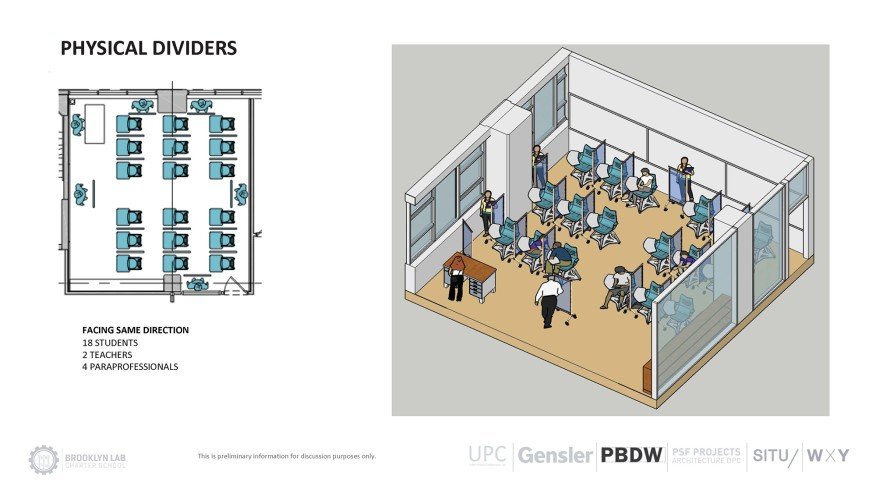Back to School Facilities Toolkit Helps Visualize School Design after COVID-19
Summer break is officially underway in most schooling districts across the country, and educators are shifting their focus from the pivot to emergency remote learning necessitated by the COVID-19 pandemic this spring, to what back-to-school might appear as if within the fall. It’s unclear, as of now, whether students are going to be ready to return to a full-time in-person instruction, or whether some combination of in-person and remote teaching are going to be required. But what’s certain is that resuming in-person instruction would require changes to the physical school environment to accommodate social distancing and new procedures like temperature checks before entry.

To that end, the Brooklyn Laboratory public school (LAB) in Brooklyn, N.Y. partnered with the Urban Projects Collaborative consultancy, and five design firms—Gensler, PBDW Architects, PSF Projects, Situ, and WXY Architecture + Urban Design—to create a Back To School Facilities Tools Kit. The 101-page document proposes ideas and precedents for planning and styling strategies to attenuate the potential spread of COVID-19 during arrival and departure, also as in classroom settings.
This first iteration may be a jumping-off point that will be refined over the course of the summer to get the simplest possible solutions by the time school reopens within the fall. And within the spirit of transparency, the varsity has made the document available for download both for analysis by the varsity community because it goes through a period of public comment, feedback sessions, and iterative charettes, and as a resource for other schools consider similar precautions.
Schools across the country are anticipated to reopen this fall, but there’s no clear road map for a way to try to this while prioritizing health and safety, especially for schools in dense urban environments. The “Back To School Facilities Tool Kit” is meant to function as a collective, collaborative resource that any school can use to start out conversations and start preparation around the way to protect the well-being of scholars, teachers, staff, and their families. The Tools kit, which can still evolve to the realities of the pandemic, puts equity at the core, offering solutions that will effectively serve all community members, particularly students with disabilities.
“All reopening preparation must consider the requirements of medically fragile relations, individuals with disabilities, people of colour, and other groups who are disproportionately suffering from the results of the pandemic,” said Eric Tucker, co-founder, and executive, LAB. “We are sharing this Tools kit not only to solicit feedback on an early version of our own approach to reopening at LAB but to supply a collaborative framework for conversations with schools across the country.”
No school has the time or resources to tackle all challenges associated with these upgrades alone, and LAB believes in advancing solutions that embrace equity. “As a laboratory school, we believe that creating, and widely sharing design solutions and tools for effective adaptation is a component of our mission,” said LAB chief treasurer Sheryl Gomez. “We encourage all school leaders to start the careful preparation and revision of plans necessary to satisfy the requirements of all learners this fall.”
As a founding partner of the Educating All Learners Alliance—a new partnership dedicated to educating all learners during the COVID-19 humanitarian disaster—LAB is going to be distributing the Tools kit through the network and beyond.
Ideas from the carpenter’s kit include:
- The way to map a journey from home to high school that integrates new requirements for health and safety. The primary set of ideas focuses on the arrival and entry process as students, and staff transition into the building, taking into consideration the egress challenges LAB and lots of other schools face.
- The way to upgrade classrooms to suits social-distancing requirements. The second set of ideas focus on practical and feasible re-mapping of classrooms, breakout rooms, and customary spaces. These classroom upgrades specialize in service mandates for kids with disabilities and therefore, the well-being of all members of the school community.

The Tools kit aligns with standardized health and safety recommendations from education leaders, also as the LAB’s own goals to create equity into the school reopening design.
The standardized recommendations include:
- Maintaining physical distancing.
- Putting the infrastructure and resources in situ to check, trace, and isolate new cases.
- Deploying public health tools that suit federal, state, and native guidelines regarding COVID-19.
- Involving workers, teachers, unions, families, students, and communities altogether planning.

Beyond meeting these requirements, the LAB set three additional goals for the Tools kit. It must be:
- Focused on meeting the requirements of all students, especially students with disabilities.
- Practical and straightforward to adapt to ever-changing circumstances.
- Modifiable to be used by other schools in other contexts.



